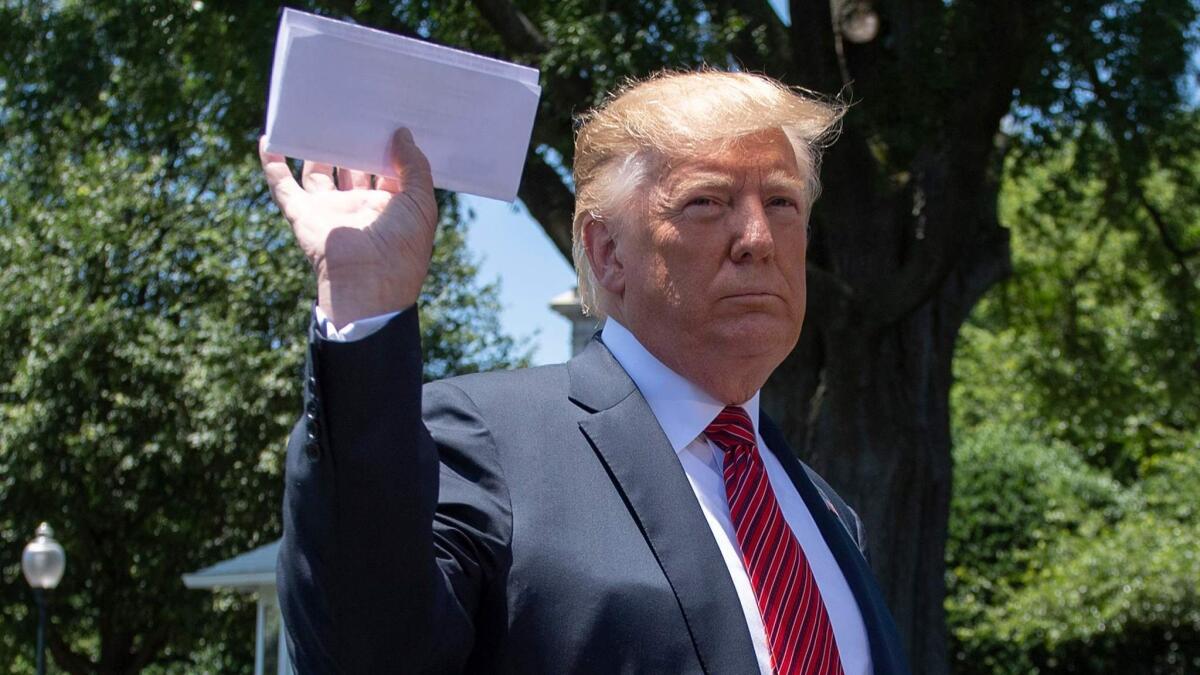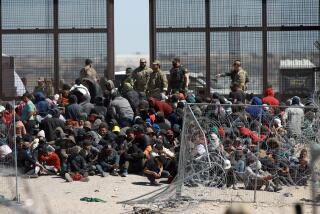Op-Ed: Trump’s hardball tactics could implode Mexico’s immigration system

Despite Friday’s last-minute deal between the United States and Mexico, President Trump continues to hold out the threat of across-the-board tariffs if the number of Central American migrants arriving at the U.S. border isn’t significantly reduced in the coming months.
Playing hardball with Mexico scores Trump points with his political supporters, but it could backfire horribly as immigration policy. A southern neighbor with an economy wrecked by trade barriers and overwhelmed by Central American migration is recipe for a humanitarian crisis right at our doorstep.
In the face of Trump’s bellicose border rhetoric, it is easy to miss the fact that since the 1990s, Mexico steadily has become the United States’ virtual wall keeping out Central American migrants. Four years after the North American Free Trade Agreement came into force in 1994, President Ernesto Zedillo carried out Operation Sealant to stymie the flow of migrants by deploying the armed forces to Mexico’s southern border. Shortly after Mexico’s democratic transition in 2000, President Vicente Fox adopted Plan Sur, which created security belts along the Isthmus of Tehuantepec, as well as along the Pacific and Gulf coasts.
If Mexico’s immigration system breaks down, two decades of progress and cooperation could unravel. The consequences for the United States would be dire.
President Felipe Calderon further militarized efforts to deter, intercept and deport Central American migrants, including the 2006 Reordering of the Southern Border Plan. In 2014, President Enrique Peña Nieto adopted Plan Southern Border after there was a spike in unaccompanied minors reaching the U.S.
Though he doesn’t have a fancy-sounding plan, President Andres Manuel Lopez Obrador’s administration has also been cracking down on transitory migration. It’s been conducting raids to arrest undocumented migrants and intercepting caravans; now it says it will add 6,000 troops from its new national guard to the effort.
Over 20 years, these policies have spawned a network of immigration enforcement across Mexico that are aligned to U.S. interests, including the 12 naval bases in the country’s rivers along its southern border and drone surveillance. Checkpoints have multiplied. Grupo Beta Force, an inter-agency task force created in the 1990s to protects migrants from predatory crime, now also reports their whereabouts to law enforcement.
Contrary to conventional wisdom in the U.S., these efforts have reduced Central American migration to the United States. Since 2015, Mexico has been deporting more Central Americans annually than the United States. And, despite the surge in U.S. Border Patrol apprehensions this year, Mexico’s immigration system has contributed to a larger downward trend since 2000.
This has come at a cost to Mexico. With migrant routes more dangerous and human smuggling costing more, a growing number of Central Americans are staying in Mexico. The number of people asking for asylum in Mexico jumped from about 1,200 in 2013 to 29,000 last year. Mexico has also allowed about 8,000 asylum seekers to wait in Mexican territory for the resolution of their cases before U.S. authorities.
Still, there is a limit to how much Mexico can do. The country’s immigration system is already stretched to near the breaking point. Migrant camps are overflowing. In December, Mexico tried offering Central Americans a “humanitarian visa” to stay in the country legally for 90 days. Overwhelmed by the number of requests, the government quickly had to shut the visa program down. Reports of government abuse of migrants have increased, as have arrests of advocates for migrants’ rights.
Enter the Fray: First takes on the news of the minute from L.A. Times Opinion »
The White House has been pushing Mexico to sign a “safe third country” agreement, which would require migrants fleeing violence and poor economic conditions to request asylum in the first country they reach. This would considerably reduce Central American migration to the U.S., since Guatemalans would have to request asylum in Mexico. But Mexico has its own struggles with violent crime; any attempt to make it a safe third country for asylum seekers would be disingenuous. Even worse, it’s unclear that Mexico has the capacity to absorb this shock.
If Mexico’s immigration system breaks down, two decades of progress and cooperation could unravel. The consequences for the United States would be dire. The Lopez Obrador administration estimates it prevents about 250,000 migrants per year from ever reaching the U.S. border; that enforcement could end. If economic hardship — whether induced by tariffs or a migrant crisis — pushes Mexican migration to its 1990s levels, that would mean another half-million Mexicans attempting to cross the U.S. border each year, too.
This crisis begs for U.S. action to address the root causes of outmigration in Honduras, Guatemala and El Salvador. Instead of cutting foreign aid or undermining anti-corruption efforts as the Trump administration threatened in recent months, the U.S. should invest in economic development and assist efforts to strengthen law enforcement and judicial institutions in the region. Otherwise, without a major improvement of living conditions in Central America, the specter of a major humanitarian crisis will continue to haunt both the U.S. and Mexico.
Gustavo A. Flores-Macías is an associate professor in the department of government at Cornell University.
Follow the Opinion section on Twitter @latimesopinionand Facebook
More to Read
A cure for the common opinion
Get thought-provoking perspectives with our weekly newsletter.
You may occasionally receive promotional content from the Los Angeles Times.






